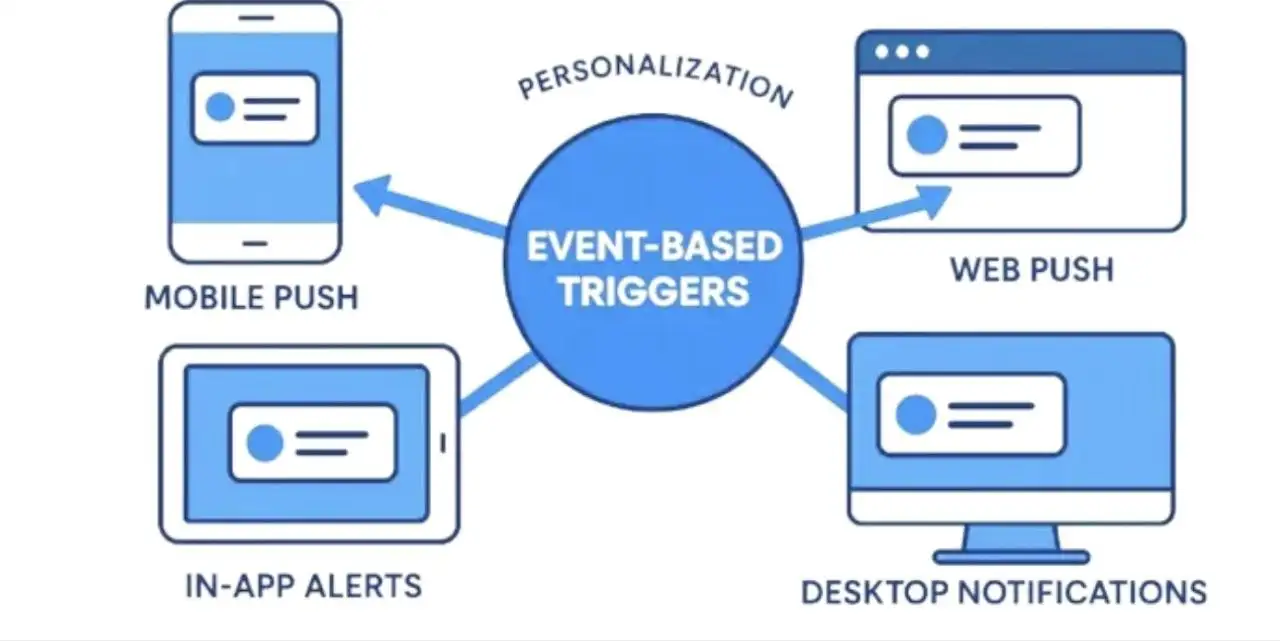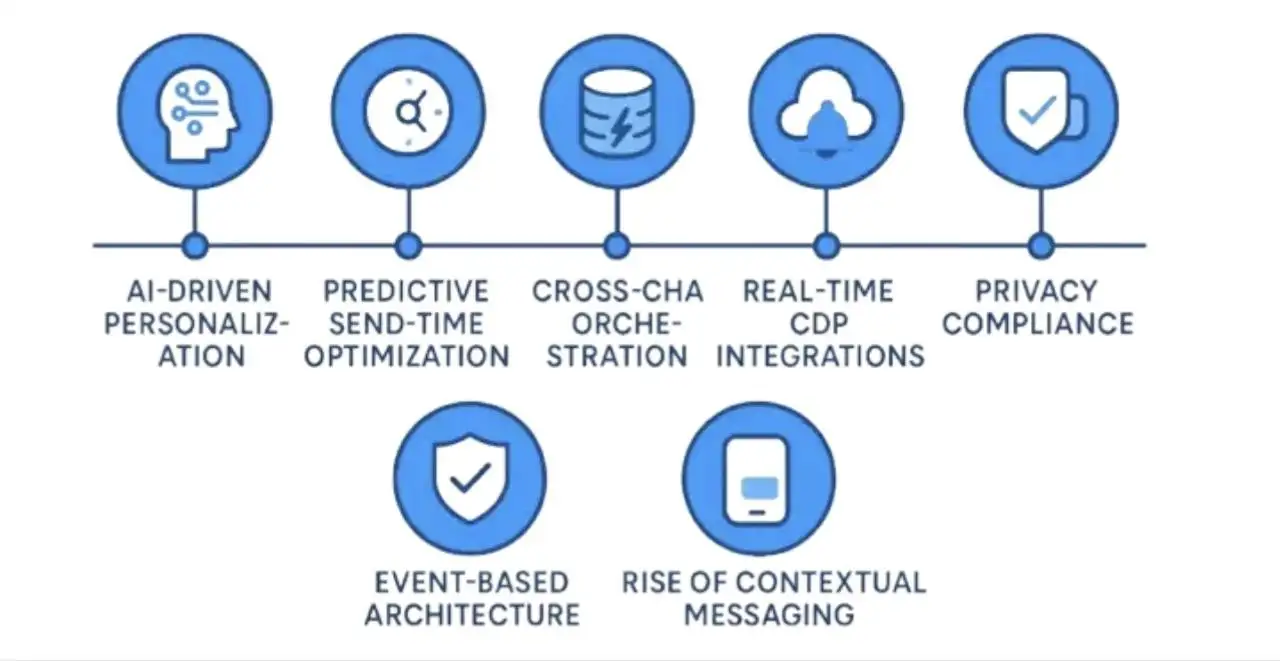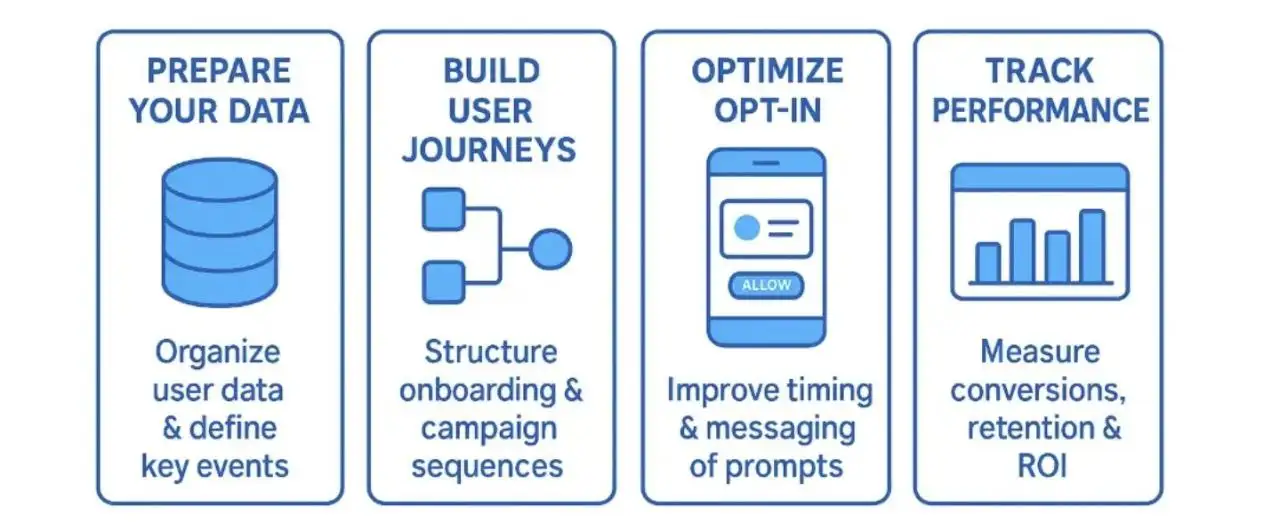We test and review software products using an independent, multipoint methodology. If you purchase something through our links, we may earn a commission. Read about our editorial process.
In 2026, push notifications have moved far beyond simple alerts. They’ve become one of the most effective ways to keep users engaged, guide them through product experiences, and bring them back at the exact moment their attention matters most. With competition for user attention at its peak, choosing the right push notification service directly influences retention, conversion, and the overall value you get from every acquired user. This is no longer a “nice-to-have” channel — it’s a core part of how modern products communicate.
The landscape itself has changed as well. What started as a mobile-only feature has evolved into a full ecosystem of real-time, cross-channel messaging. Mobile push, web push, in-app alerts, desktop notifications, event-based triggers — all of these now work together to create a consistent, personalized communication flow across devices. Users expect fluid, relevant interactions, and businesses need platforms that can match these expectations without adding complexity.

This buyer’s guide is built to give you clarity in a crowded market. You’ll see what actually matters when comparing push notification platforms in 2026, which capabilities have a measurable impact, and what separates a reliable, scalable solution from an outdated one. By the end, you’ll understand the trends shaping this space, the features worth investing in, and how to confidently choose a push notification service that supports your long-term growth.
Push notification services are platforms that deliver real-time messages to users across mobile apps, websites, and desktop devices. At their core, these services help businesses reach people instantly — without relying on email inboxes, social feeds, or channels where messages get lost. A good push notification platform does more than “send alerts”: it connects your product data, user behavior, and communication strategy into a single system that can react to what a user is doing right now.
In practice, this means the service manages several things behind the scenes: device registration, message routing, delivery optimization, user segmentation, and analytics that show how people respond. Instead of building this infrastructure yourself, push notification platforms give you a ready-made environment where you can create campaigns, automate triggers, and track performance in real time.
Today, push notifications cover several formats — mobile push, web push, in-app messages, desktop alerts, and event-driven system notifications. All of them work together to guide users through onboarding, highlight important updates, recover lost conversions, and support long-term engagement. In 2026, the definition of a push notification service isn’t limited to sending messages; it’s about delivering timely, personalized communication across every device your audience touches.
Push notifications have evolved from simple reminders into a critical channel for real-time engagement. In 2026, users expect instant, context-aware communication that feels relevant rather than intrusive. Generic mass notifications are no longer effective — modern audiences respond to messages that match their behavior, location, and stage in the customer journey.
Users today move seamlessly between apps, browsers, and devices, and they expect your product to keep up. A delay of even a few hours can mean missed opportunities for engagement, conversion, or retention. Push notifications allow brands to reach users at the exact moment they are most likely to take action — whether that’s completing a purchase, returning to an app, or engaging with a feature they haven’t explored yet.
Privacy regulations and stricter platform policies are reshaping how businesses communicate. Opt-in rates, consent management, and compliance with GDPR, CCPA, and other regulations are now central to push strategy. The platforms that respect user privacy while still enabling targeted communication will define which brands succeed in 2026.
Push notifications are no longer one-size-fits-all. Personalization across the user lifecycle — onboarding, engagement, retention, and reactivation — is essential. Messages triggered by behavior, preferences, or milestones drive higher conversions and deeper user loyalty. A well-executed personalized push strategy turns notifications into a meaningful touchpoint rather than just noise.
In short, push notifications in 2026 are about relevance, timing, and trust. The right service doesn’t just send messages — it helps you engage users at the right moment with the right content, respecting their preferences and privacy.
Push notifications aren’t just a “reminder tool”; in 2026, they power multiple stages of the user journey. Understanding the right use cases helps brands maximize engagement and ROI.
Push messages can guide new users through setup, feature discovery, and first actions, ensuring they quickly see value and remain engaged. Timely, contextual notifications increase the chance of adoption and reduce early churn.
Re-engagement and retention
For users who have fallen dormant, notifications act as gentle nudges to bring them back. Messages triggered by inactivity or milestone achievements keep your audience active without being intrusive.
Critical updates — like purchase confirmations, password resets, or subscription changes — need fast, reliable delivery. Push notifications offer a direct line to ensure users receive timely, essential information.
Sales, special offers, or seasonal campaigns perform best when they reach users in real time. Notifications allow brands to cut through crowded inboxes with concise, relevant messages.
E-commerce brands rely on push notifications to recover lost sales by reminding users of pending carts or items left in wishlists, often boosting conversion rates significantly.
Keeping users informed about new features, enhancements, or important product announcements increases engagement and strengthens brand loyalty.
Behavioral triggers — such as location, app usage, or content interactions — enable hyper-personalized communication. Event-based messages drive deeper engagement by delivering the right message at the right moment.
In 2026, push notifications are becoming smarter, more contextual, and tightly connected to real-time user behavior. AI now handles much of the personalization and segmentation automatically, while predictive send-time optimization ensures messages arrive at the exact moment users are most likely to engage. Push no longer works in isolation — platforms integrate deeply with email, SMS, in-app messaging, and CDPs to create unified, data-driven journeys.

Event-based architecture is replacing traditional batch campaigns, making notifications more relevant and timely. At the same time, stricter privacy regulations and data residency requirements are shaping how platforms store and process user information. As a result, generic broadcast messaging continues to decline, and contextual, behavior-driven communication has become the industry standard for meaningful engagement in 2026.
Choosing the right platform means understanding not just delivery, but capabilities, flexibility, and long-term scalability.
1. Core Delivery Capabilities
Multi-platform support (iOS, Android, web, desktop)
High deliverability with low latency
Reliability backed by performance SLAs
2. Personalization & Targeting
Deep segmentation for meaningful audiences
Dynamic content based on behavior, preferences, or events
AI-assisted predictions to anticipate user needs
3. Automation & Workflow Builder
Visual drag-and-drop campaign builder
Event-driven triggers and automated sequences
A/B and multivariate testing to optimize messaging
4. Analytics & Reporting
Real-time dashboards for engagement metrics
Attribution models linking notifications to conversions
Cohort and retention analytics to measure long-term impact
5. Integrations & Ecosystem
SDKs and APIs for seamless setup
Built-in integration with CRMs, e-commerce platforms, and CDPs
Webhooks and data sync for custom workflows
6. Privacy & Security
GDPR/CCPA compliance and opt-in management
Data encryption in transit and at rest
Configurable storage options based on regulatory needs
8. Developer Experience
Easy setup and lightweight SDKs
Comprehensive, clear documentation
Strong technical support and troubleshooting tools
Understanding how push notification services charge is essential when planning campaigns and scaling your user engagement strategy. In 2026, pricing varies depending on user volume, message frequency, and the features you need. Some platforms base costs on monthly active users, meaning your fees fluctuate with the size of your engaged audience.
Others calculate pricing based on the number of notifications sent, which works well for campaigns with predictable messaging patterns. Certain vendors structure pricing around feature tiers, giving access to advanced tools like automation, AI personalization, or analytics only at higher levels. API usage is another common model for companies that rely heavily on programmatic messaging.
Many platforms offer freemium plans to explore basic capabilities, while enterprise packages provide scalability, enhanced security, and dedicated support. Beyond base pricing, additional costs can appear in infrastructure usage, premium support, or custom integrations, so it’s crucial to understand the full cost of ownership before committing.
Choosing the right push notification service is not just about features; it’s about reliability, scalability, and alignment with your goals. On the technical side, deliverability is paramount — a service that can’t reliably reach your audience in real time is effectively useless. The performance and footprint of the platform’s SDK also matter, since heavy or inefficient code can slow apps down or frustrate users.
API speed, latency, and reliability become critical if your workflows rely on event-triggered messaging, and the platform must scale seamlessly for large audiences without delays.
From a business perspective, responsive customer support, a clear product roadmap, and the vendor’s reputation and stability are all vital considerations.
The right platform should match your specific use case: marketing teams need robust segmentation and automation, product teams rely on in-app messaging and feature updates, high-volume transactional workflows demand low-latency delivery, and brands pursuing omnichannel engagement require deep integration across web, mobile, and CRM systems.
Running a trial period of two to four weeks allows you to test key metrics like open rates, click-throughs, and retention impact, ensuring that the platform performs under real-world conditions before making a long-term commitment.
Even the most powerful push notification service can fail to deliver results if implemented poorly. One of the most common errors is overusing notifications, which can quickly annoy users and lead to churn. Ignoring segmentation or personalization also undermines engagement, as generic messages fail to resonate with individual users.
Choosing a platform without testing actual deliverability can lead to unpleasant surprises, while neglecting long-term scalability may force costly platform changes down the road.
Focusing solely on price at the expense of reliability is another frequent pitfall, and overlooking privacy and compliance requirements can expose your business to serious legal and reputational risks.Avoiding these mistakes ensures that your push campaigns remain effective, trusted, and sustainable.
Effective push notification campaigns start with careful preparation. Organizing your user data and defining relevant events ensures that messages reach the right audience at the right moment. Structuring onboarding flows and campaign sequences around the user journey improves engagement and retention.

Optimizing the opt-in process is equally important, as the timing and phrasing of permission prompts can dramatically affect participation rates. Finally, setting up analytics to track conversions, retention, and revenue impact allows teams to measure the effectiveness of campaigns and iterate continuously for better results. In 2026, success depends on using push notifications not just as alerts, but as a strategic tool to guide users, encourage action, and build lasting relationships.
Push notifications in 2026 are far more than a convenience — they are central to modern engagement strategies. The right platform enables brands to deliver messages that are timely, personalized, and respectful of user privacy. When evaluating solutions, focus on performance, personalization, and automation, and make sure to consider both technical reliability and business fit.
Avoid common pitfalls such as over-messaging, neglecting segmentation, or choosing a platform based solely on cost. By testing carefully, monitoring key metrics, and iterating your campaigns, push notifications can become a powerful driver of engagement, retention, and revenue, turning every interaction into an opportunity for meaningful user connection.
Yes. Several push notification service providers—like Pushassist and SendPulse—offer free tiers allowing a limited number of subscribers or messages per month. These free plans are ideal for startups and bloggers testing web push notifications before upgrading to paid tiers.
That depends on your plan. Some best push notification services bill per subscriber, while others charge per message. Free or entry-level tiers may cap you at a few thousand notifications, whereas higher-tier plans (or unlimited-message plans) let you send millions. Always review pricing and projected volume to avoid surprise overages.
Web push notifications are delivered to desktop and mobile browsers (Chrome, Firefox, Safari) without requiring an app install. Mobile push notification services use platform-specific channels—Firebase Cloud Messaging for Android or APNs for iOS—to reach users within a native app. Each channel has unique requirements for subscriptions, payload size, and delivery reliability.
Absolutely. Modern push notification software includes segmentation tools that leverage user behavior, device type (desktop vs. mobile devices), location, and custom attributes. By targeting specific audience segments, you’ll see higher open rates, better user engagement, and improved retention.
Focus on delivery rates, open rates, click-through rates, and conversion rates. Advanced analytics—like time-to-open or session duration after a push—provide deeper insights into user behavior. Use A/B testing to experiment with notification templates, headlines, or send times (right time optimization) for continuous improvement.
Basic integration often requires pasting a JavaScript snippet for web push or installing an SDK in your mobile app. Most push providers offer clear documentation, code samples, and RESTful APIs so even non-developers can set up subscriptions, triggers, and automation workflows with minimal effort.